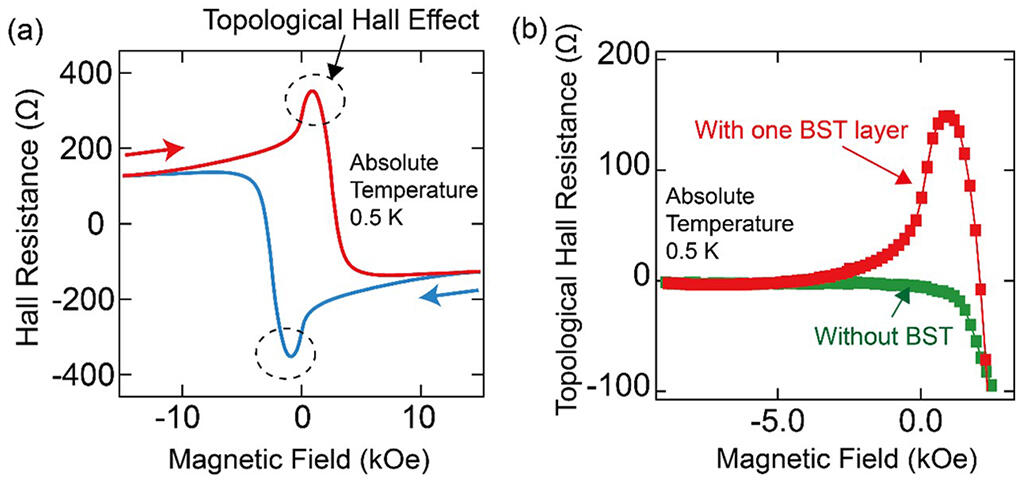A group comprising of Graduate Student Takuya Takashiro, Assistant Professor Ryota Akiyama, and Professor Shuji Hasegawa of the Department of Physics, The University of Tokyo, and Associate Professor Toru Hirahara and others of the Department of Physics, Tokyo Institute of Technology National Institute for Materials Science, through an international collaborative research with Senior Researcher Taisuke Sasaki of the National Institute for Materials Science, Professor A. A. Saranin of the Russian Academy of Sciences, and others, used a topological ferromagnet MnBST:Mn(Bi,Sb)2Te4 containing a single atomic layer in which manganese atoms with spin (micro magnet properties) were regularly and densely arranged to fabricate an "atomic layer sandwich structure" by sandwiching the top and bottom of the topological insulator BST: (Bi,Sb)2Te3 atomic layer and measured its electrical conductivity. The topological Hall effect was observed in a weak magnetic field with approximately one-tenth of the conventional intensity, along with the formation of a micromagnetic vortex (skyrmion).
Usually, the Hall effect of a ferromagnet is expressed by the sum of the normal Hall effect proportional to the applied magnetic field and the anomalous Hall effect proportional to the intensity of magnetization. On the other hand, in a ferromagnet where a skyrmion has been induced, it is also necessary to add the topological Hall effect, which depends on the strength of the virtual magnetic field (emergent magnetic field) induced by the skyrmion. This study confirmed that Hall resistance rises like a hump in the applied magnetic field region where the skyrmion vortex is formed, which proves the topological Hall effect. Further, by comparing the situation where the BST layer is inserted between the two layers of MnBST in a sandwich structure with one where BST is not inserted, it was revealed that topological Hall resistance is observed only in the presence of the BST layer.

(b) Comparison of the sandwich structure with and without the one BST layer. The one layer of BST between the two MnBST layers stabilizes the skyrmion and the topological Hall effect is observed.
Provided by The University of Tokyo
This is the first evidence that skyrmions are not stabilized by simply laminating two layers of MnBST but by coupling the magnetic topological surface states of the upper and lower surfaces of the BST layers with a sandwiched structure. In addition, compared with the conventionally reported topological ferromagnets where manganese atoms are added in a disordered manner, it was proven that the observed skyrmion could be produced by applying a weak magnetic field with approximately one-tenth of the conventional intensity. In this system, the ferromagnetic interaction was considered to be intensified by the ordered and dense arrangement of manganese atoms at the atomic level by self-formation. It became clear that the state of arrangement of the magnetic atoms significantly influences the characteristics of the skyrmion.
Assistant Professor Akiyama commented, "Because of the fierce global competition in research, there is always the possibility that the results of this research will be surpassed by other groups. The discovered phenomena can only be seen at temperatures as low as -260 ℃, so we would like to devise the structure of the atomic layer further to enable observation even at temperatures close to room temperature, which will lead to the development of practical devices that can take advantage of the features of topological insulators."
This article has been translated by JST with permission from The Science News Ltd.(https://sci-news.co.jp/). Unauthorized reproduction of the article and photographs is prohibited.




